After nearly a decade away from two wheels, I finally decided It was time to get a bicycle again.
I knew it wouldn’t be an easy process. A couple years ago I developed a vestibular (inner-ear) disorder called Ménière’s Disease, a major side effect of which is a poor sense of balance — not exactly ideal for cycling. Luckily, I recently managed to find a local professional cycling coach who specialized in working with adults with balance issues. Her skill and patience took me from completely unable to balance all the way to riding functionally within 90 minutes.
But what I found especially interesting about the lesson is how she described the bike she brought for me to practice on. “She’s real gentle and stable,” the coach explained. “You can trust her. She never leads a beginner astray. I bought her for myself originally, but I could immediately tell she actually wanted to help new folks, so that’s her job now, and she loves it.”
I’m not sure how literal the coach was being, but it was a fascinating comment, and an unexpected bit of animism outside of the pagan community. My own practice of animism does not typically extend to inanimate objects, which seems to loosely align with some Stoic viewpoints of divine pneuma. Pneuma, although present everywhere, “does not give consciousness and reason to all things;” it provides inanimate objects “their inner coherence and physical properties (hexis), including their changes,” rather than bestowing perception, mobility, self-sustenance, etc. as it does in plants and animals. [1]
Still, it gave me a lot to think about.
“The Land is Strewn in Turquoise”
Not long afterwards, I bought my own bike at a local shop: a Specialized Sirrus X 4.0, a lovely hybrid that would do as well on gravel trails as it would around town. When the time came to pick the color, I immediately gravitated towards the bright turquoise option.
Turquoise was a highly regarded sacred stone in Ancient Egypt, evidenced by even a passing glance at their jewelry. But before I get too far along, it’s worth pointing out that Ancient Egyptians didn’t have the same color terminology that we use in English. Instead, the categories were more general:
“Red and yellow were characterized as the same color, classified as “warm color” with a focus in red, and blue and green were classified as “cool color” with a focus in green. Middle Egyptian, therefore, had four basic color words: black, white, “warm color,” and “cool color.” The initial color categories were white (HD), black (km), red (dSr), and green (wAD).” (DeDeo 2013)
[2] DeDeo, C. (2013). Yellow, Red, and Blue: A Symbolic and Linguistic Analysis of Gendered Colors in XIX Dynasty Egyptian Mortuary Art. Providence College Journal of Art. Retrieved here.
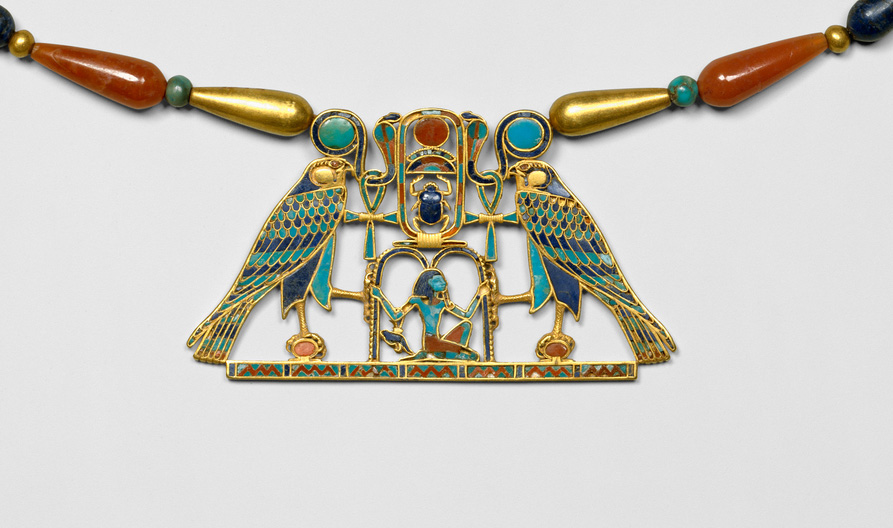
Turquoise (mfkAt, often rendered as “mefkat”) fell into that “green” category. It was especially valuable “because this color was connected to ‘the sun at dawn, whose disk or rays might be described as turquoise and whose rising was said ‘to flood the land with turquoise.'” [3] One hymn in the tomb of Horemheb in Saqqara “states that ‘the land is strewn with turquoise by the setting sun and with white gold by the rising sun,” thus setting up a contrast between the failing light of the evening sky and the brilliant rays of the morning sun” (ibid). Turquoise is often referenced in funerary texts as well, with some lovely examples like Coffin Text spell 61 (“may bars of silver be brought for you, to the bowl with the turquoise rim”) and in the tomb of Rekhmire in Thebes (“may you ascend to the sky garlanded with faïence pendants and clad in turquoise.”) [4]
And while the genuine semiprecious stone was indeed highly valued, other substances with similar properties were often prized almost or equally as much. Color-related terminology in the Egyptian language tended to “more closely denote ideas of quality, character, or material/substance rather than color,” which is quite distinct from how it is used in Indo-European languages. [5] This broader definition of color means that when it came to semi-precious stones, “it was as much their surface polish that was valued as their color,” and the ability of sparkling material to capture solar light made it “an aid in bestowing life to inanimate objects, in two or three dimensions.” [3] This is likely one reason why faience, the turquoise-bluish glass used in jewelry and figurines, was viewed as valuable and magically potent, despite its human-made origin.
Looking at my intensely tropical-blue bike, it seemed to fit the bill. It certainly had the “surface polish” that reflected light that was prized to the ancient Egyptians. Underneath the paint, the frame of the bike is aluminum (gods know I couldn’t afford a carbon fiber model), which would’ve been unknown to the Egyptians as a standalone metal; they worked only indirectly with the aluminum occurring within sand. [6] And even if I’d bought a heavier steel bike, that also wouldn’t have been especially symbolically interesting. The Egyptians were latecomers to the utilization of carburized iron, preferring copper-alloy tools and weaponry instead, which likely led to a strategic disadvantage against their neighbors (ibid). But since aluminum is rather silvery looking, and the bones of the gods are said to be made of silver [4] perhaps that’s something.
But I promise I did eventually ride the bike instead of just thinking about its symbolic color associations.
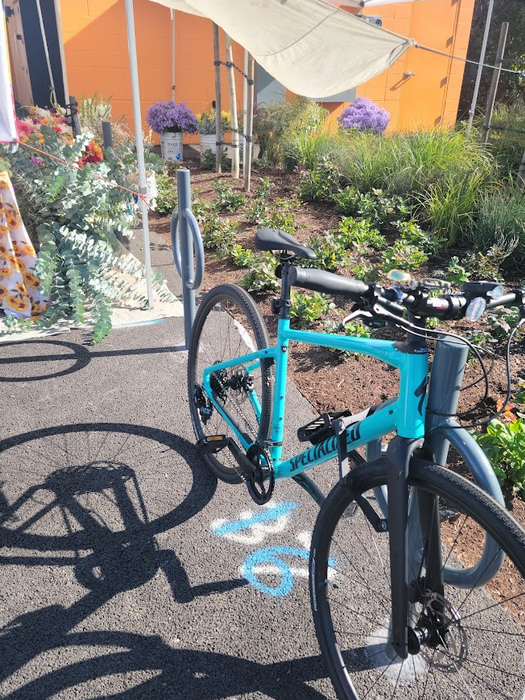
Guardians and Wanderers
The first few rides were admittedly rocky. Although that initial coached lesson was helpful, it didn’t cure my balance issues or my generalized anxiety disorder that manifests itself in an utter terror of pretty much anywhere except safe separated bike paths. As I was shakily navigating across a narrow footbridge, I remembered an ex of mine (a semi-professional cyclist) who once told me that to improve my handling, I simply needed to trust the bike. “It wants to stay upright, it wants to follow your line of sight,” I remember him saying. He was talking about the gyroscopic effect, but it reminded me of the coach describing her bike as helpful and gentle.
And that’s when I decided that I might as well ask for some additional help. What if the bike really did want to stay upright, not just due to physics, but on principle as well?
The concept of inspirited objects was not foreign to the ancient Egyptians. Perhaps the most well-known example is the shabti or ushabti, humanoid mummiform figurines interred in tombs with the intent to perform manual labor on behalf of the deceased in the afterlife. Assmann [4] convincingly argues that shabtis were viewed as an “extended identity” of the deceased rather than unique entities unto themselves, which contradicts the common impression that they represented some sort of army of spiritual servitors.
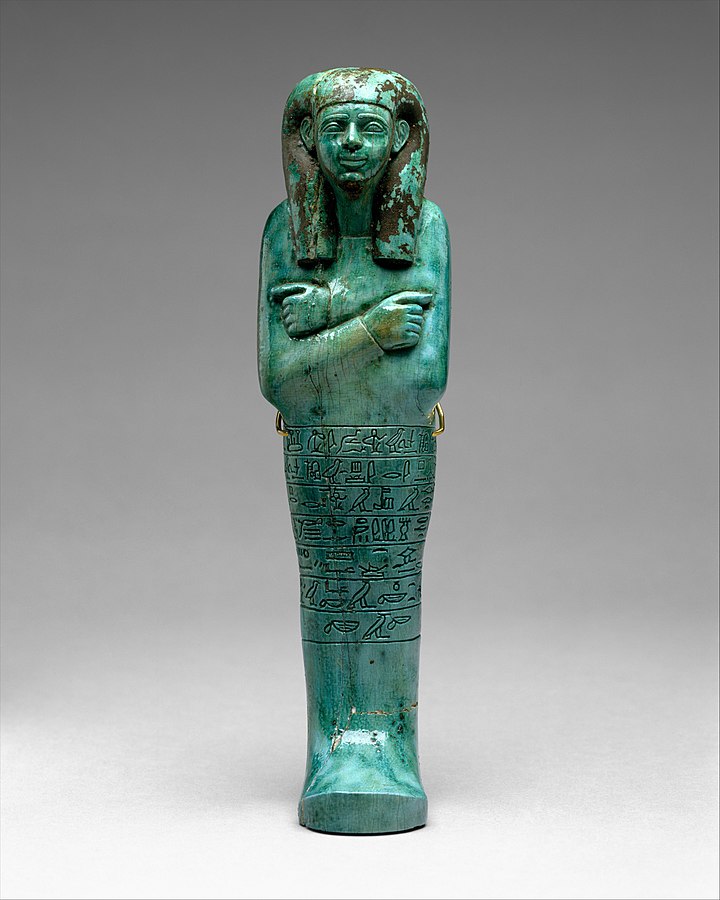
A spiritual servitor wouldn’t have fit me anyway. While I understand that creating and/or binding servitors is standard practice among many pagans, it goes against my personal ethics. And working with an extension of my own self would be equally disastrous, assuming it maintained my anxious temperament. What I really needed was an independent third party to help me out–like the coach–so I turned to the broader categories of “non-human spirits” in Egyptian cosmology.
There’s no singular term for non-deity spirits in Egyptian cosmology, though they do feature quite often in funerary texts in particular. Essentially, they are any (semi-)divine entity that is not a deity and also not human in origin (i.e. not a human ghost). Many English-language papers use the term “demon,” others prefer “daimôn” or “genii” to avoid negative associations with “demon,” and Kemetic Orthodoxy uses “netjeri.” In a nutshell:
“The main difference between demon and deity seems to be that demons received no cult, at least until the New Kingdom. Within the hierarchy of supernatural beings, demons are subordinate to the gods; although they posses special powers, these powers are not universal but rather limited in nature and scope. In general, their influence is circumscribed to one single task, and in certain cases they act under the command of a deity. The available sources do not elaborate on the origin of demons; nor are they explicitly mentioned in creation accounts. However, as they often act as emissaries of deities and are subjected to their will, we may deduce that demons are a creation of the gods.”
[7] Lucarelli, R. (2010). Demons (benevolent and malevolent). In J. Dieleman & W. Wendrich (Eds.), UCLA Encyclopedia of Egyptology. Los Angeles, CA: UCLA Press. Retrieved here. (Bolded emphasis added by me.)
These spirits are almost always depicted in funerary texts with knives or other weaponry, and tend to appear in some sort of hybrid human-animal form, or even something stranger (like a bunch of legs). Plenty of these spirits are actively hostile towards human beings, including when under the directive of one of the gods (such as the famously intimidating “Seven Arrows of Sekhmet”), and some simply guard an area of the pathway to the Afterlife, attacking only those who fail their tests. “Wandering” spirits were often considered some of the most dangerous, bringing injury and disease in their wake.
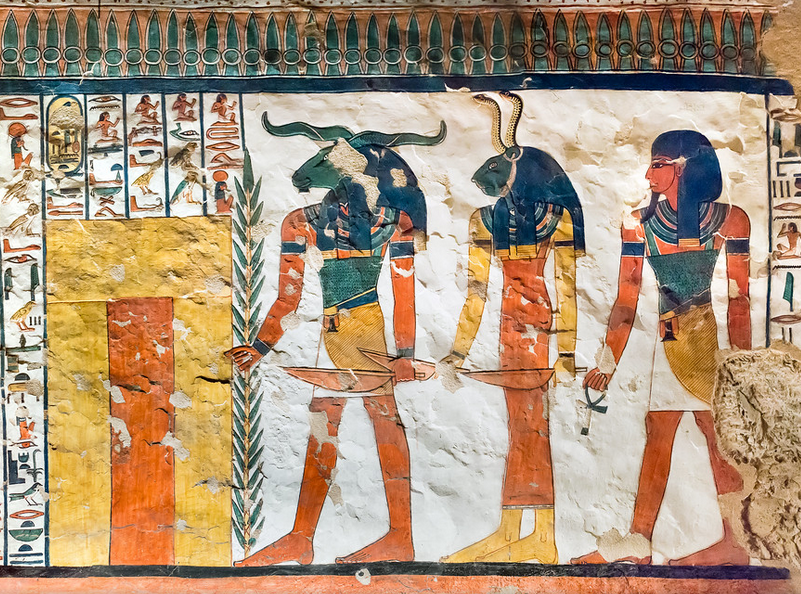
But luckily, some of these spirits can be quite benevolent. When asked for assistance, some guardian spirits “also helped to guard humans on earth from those demons who have come over to assault them from the afterlife.” [8] One of the most common ways to call upon these spirits was to carve their likeness(es) (and sometimes a simple spell requesting their protection) onto an item, oftentimes a boomerang-shaped “wand,” but other objects such as headrests and jars have been found as well. Szpakowska [8] explains that “the function of many spells was to create a sacred safe protected space which the demons would have to pass by, ensuring that they were not allowed entry. Those that penetrated this defensive perimeter were greeted by ruthless counterattacks directed by the gods as well as savage genies armed with an array of weapons.”
This gave me the idea to transform my bike into one of those “safe protected spaces.” If a wand or a headrest could be a magical vessel fit for a protective daimon, why not a bicycle? And riding a bike is a rather liminal activity, as a form of travel where one is neither here nor there, neither pedestrian nor motorized vehicle, so an in-between-dwelling spirit would be right at home.
“I know the name of the god who guards you”
First step complete: I had decided to invite a benevolent protective spirit to take up residence in my bike, if it pleased them.
Step 2: we needed a name. Guardian spirits typically had epithets or descriptors as names [8], so I went with the simple Mefkat, turquoise. It was both descriptive and (hopefully) magically potent, given the associations turquoise had in Egyptian thought.
Step 3: whose protective spirit will this be?
As noted in Lucarelli’s quote above, guardian spirits frequently operate under the purview of a specific deity. In the Book of the Dead, the deceased repeatedly tells guardians to “make way for me, since I know you, I know your name, I know the name of the god who guards you.” [9] (Lucarelli likens this to some concepts in Platonism, but that’s out of my area of familiarity.)
When asking for assistance, my first instinct is to ask the deities with whom I have the closest relationships. As I’ve noted before, gods are complete individuals with a limitless skill set; they’re not limited to one specific functional area. But from the moment I had settled on the name Mefkat, the deity who came to mind was one I had almost no relationship with: Hathor.
This shouldn’t have surprised me, as Hathor is arguably the ancient Egyptian deity par excellence in regards to turquoise. One epithet of Hathor is nbt mfkAt, or “Lady of Turquoise.” In her temple in Dendera in particular, “she is held as the creator of all minerals and metals and the possessor of precious stones,” and “Hathor nbt mfkAt was worshipped in the copper mines of Timna (Sinai) as well.” [10] Hathor frequently calls upon other deities to help protect her turquoise, such as instructing Sopdu to watch over her precious materials in Sinai, while “Min controls the eastern desert seeking metals or precious minerals by order of Hathor” (ibid).
Every time I considered asking one of the Egyptian gods with whom I have regular cultus (Wepwawet, Anubis, Sobek, Isis, Tutu, Ma’ahes), I felt nudged back in Hathor’s direction. It did make sense — in addition to being the goddess of turquoise, she also has strong associations with the Underworld (which is full of those spirits) and is known to have a host of these semi-divine followers, such as “the ‘seven Hathors,’ bovine or cow-headed creatures that assist in childbirth.” [11] And she is also a goddess of joy, play, and celebration — exactly what I planned to focus on with cycling, as opposed to athletic performance. So it was decided: I’d be petitioning Hathor for help.
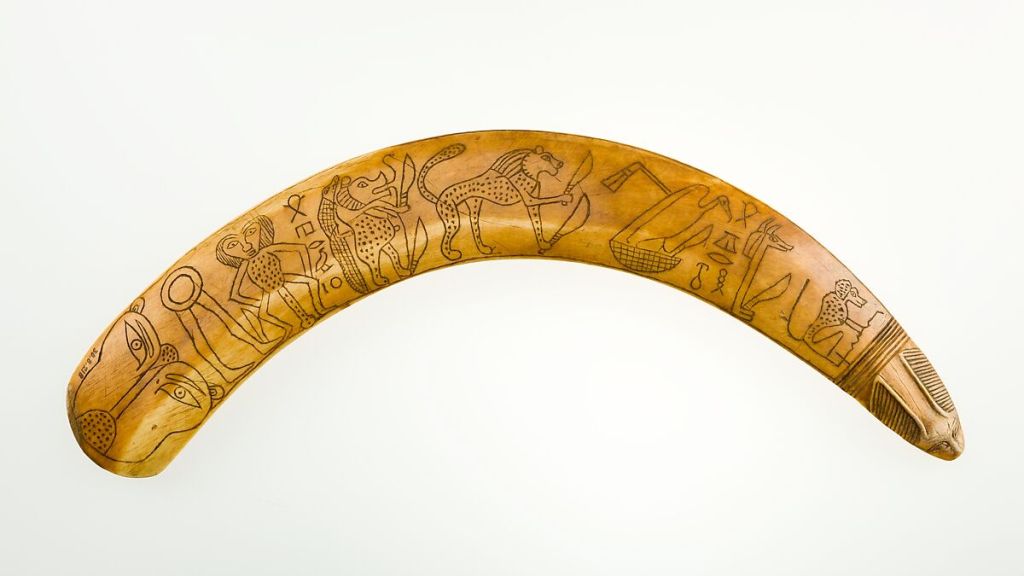
A Ritual in the Garage
Setting up my garage as a ritual space was probably the strangest at-home ritual experience I’ve had; boxed-up holiday decorations and the scent of gasoline made an interesting backdrop. The initial ritual structure was straightforward: purification, sistrum-rattling, hymns, traditional offerings of bread and beer, all with Hathor as the recipient. The hymn I recited was from a stela of King Wahanakh Intef II from his tomb in Thebes, dating from the transition to the Middle Kingdom:
O you lords of the western sky,
[12] Lichtheim, M. (2006). Ancient Egyptian Literature: Volume 1: The Old and Middle Kingdoms. Berkley, CA: University of California Press. Kindle Edition.
O you gods of the western sky,
O you who rule the shores of the western sky,
Who rejoice at Hathor’s coming,
Who love to see her beauty rise!
I let her know, I say at her side
That I rejoice in seeing her!
My hands do “come to me, come to me,”
My body says, my lips repeat:
Holy music for Hathor, music a million times,
Because you love music, million times music
To your ka wherever you are!
I am he who makes the singer waken music for Hathor,
Every day at any hour she wishes.
May your heart be at peace with music,
May you proceed in goodly peace,
May you rejoice in life and gladness
With Horus who loves you,
Who feasts with you on your foods,
Who eats with you of the offerings,
May you admit me to it every day!
Once offerings had been given, I made my case to Hethert, asking that she enlist one of her attendant spirits–which I would name Mefkat–to inhabit my bike, should it be pleasing to all parties. (And included the provision that the spirit could leave at any time.)
Divination via the fantastic Egyptian Star Oracle confirmed that my request had been accepted, and I was delighted that the card I pulled included a little spotted cow in the artwork, which is perfect for Hathor. I then greeted and made offerings to Mefkat, and asked if the spirit had any messages for me. The artwork on the card jumped out at me immediately: it depicted Hapi, one of the very few deities to be portrayed in blue–an animating color–and who personified the Nile. Blue Interestingly, this divination indicated that there was a need for purification, whether literally or figuratively. (I really hope this doesn’t mean I’m going to crash into the nearby river…) I also asked Mefkat what sort of entity they’d like to be depicted as, and the spirit on the card I pulled was a humanoid-legged snake — a surprisingly common form for Egyptian spirits.
With many thanks and promises of regular offerings, I closed out the ritual. Had it not been raining heavily, I would’ve gone out for a celebratory ride.
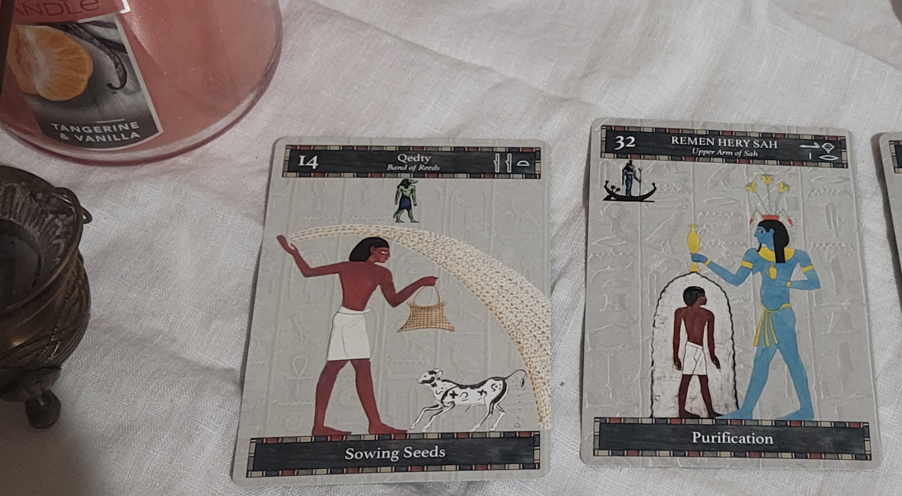
Closing Thoughts
Between purchasing the bike and performing this ritual, I rode about 81 km (52 miles), and I’m happy to report that my handling skills have increased significantly from my first baby-deer-awkward rides. It’ll be interesting to see how this new relationship with this spirit impacts my riding, if at all. I’m incredibly dense when it comes to perceiving spirits, so perhaps I won’t notice much of a difference. Or perhaps Mefkat will leave abruptly out of boredom or frustration. Either way, I’m enormously grateful to Hathor, and this exercise was an interesting way to link my spirituality with another key part of my life, endurance sport.
I’d be curious to hear the experiences of others in this broader area as well!
Amusingly, when WordPress auto-generated an excerpt for this post, it mistakenly assumed that this whole thing was a back-and-forth discussion between me and my cycling coach. I don’t think I’ll mention that to her when I see her next.
References
[1] Frede, D. (2003). Stoic Determinism. In B. Inwood (Ed.), The Cambridge Companion to the Stoics (Cambridge Companions to Philosophy). Cambridge, UK: Cambridge University Press. Kindle Edition.
[2] DeDeo, C. (2013). Yellow, Red, and Blue: A Symbolic and Linguistic Analysis of Gendered Colors in XIX Dynasty Egyptian Mortuary Art. Providence College Journal of Art. Retrieved here.
[3] Corcoran, L.H. (2016). The Color Blue as an ‘Animator’ in Ancient Egyptian Art. In R. B. Goldman (Ed.), Essays in Global Color History, Interpreting the Ancient Spectrum. Gorgias Studies in Classical and Late Antiquity 19. Gorgias Press: Piscataway, NJ. Retrieved here.
[4] Assmann, J. (2005). Death and Salvation in Ancient Egypt. Ithaca: Cornell University Press. Kindle edition.
[5] Strong, M. E. (2018). Do You See What I See? Aspects of Color Choice and Perception in Ancient Egyptian Painting. Open Archaeology 4, 173–184. Retrieved here.
[6] Ogden, J. (2000). Metals. In P. T. Nicholson & I. Shaw (Eds.), Ancient Egyptian Materials and Technology. Cambridge, UK: Cambridge University Press. Retrieved here.
[7] Lucarelli, R. (2010). Demons (benevolent and malevolent). In J. Dieleman & W. Wendrich (Eds.), UCLA Encyclopedia of Egyptology. Los Angeles, CA: UCLA Press. Retrieved here.
[8] Szpakowska, K. (2009). Demons in Ancient Egypt. Religion Compass 3(5), 799–805. Retrieved here.
[9] Lucarelli, R. (2010). The guardian-demons of the book of the dead. British Museum Studies in Ancient Egypt and Sudan 15, 85–102. Retrieved here.
[10] Gilli, B. (2010). Under the Protection of the Gods: the Divine Role for the Good Outcome of Trade and Mining Expeditions. In A. Hudecz & M. Petrik (Eds.), Commerce and Economy in Ancient Egypt. Oxford, UK: Archaeopress. Retrieved here.
[11] Gillam, R. A. (1995). Priestesses of Hathor: Their function, decline and disappearance. Journal of the American Research Center in Egypt 32. Retrieved here.
[12] Lichtheim, M. (2006). Ancient Egyptian Literature: Volume 1: The Old and Middle Kingdoms. Berkley, CA: University of California Press. Kindle Edition.

Thank you for sharing. I’ve always had a bike as a means of local transport but oddly haven’t cultivated that much of a relationship with any of them on a spiritual level. As a reflection of this my quite nice hybrid got stolen earlier in the year and on a rebound I just bought the cheapest hybrid from my local bike shop so I could afford to insure it. I did put a protection spell on it but would have never considered inviting a spirit to reside within it. This has got me thinking about being more mindful about my relationship with my bike and beginning to relate to… should really not be it but he, her or them, actually not sure (!) as a person…
LikeLiked by 1 person
I’m sorry to hear that your bike got stolen, that’s really frustrating — for those who don’t drive, that’d be like stealing a horse in the old days… Putting a protection spell on the new one definitely makes sense! I wish you much joy with the new one.:)
LikeLiked by 1 person
I loved this post, now it’s made me want to recruit spirits to reside in my new lab instruments. The only problem would be to set up a ritual in the lab then 😬
LikeLiked by 1 person
Ooh that would be really interesting! Ha, my husband works in a lab for a blood bank, so could you imagine the awkwardness of performing a pagan ritual in a blood lab??
LikeLike
Ooof, that would be pretty awkward, especially if the incense set off the fire alarm and caused a mass evacuation.
Everybody at my institute hates the chemistry department because people forget gloves in the furnaces and set everything off on the reg.
LikeLiked by 1 person
Oh yikes, fire drills are never fun…
LikeLike